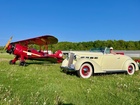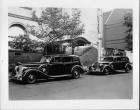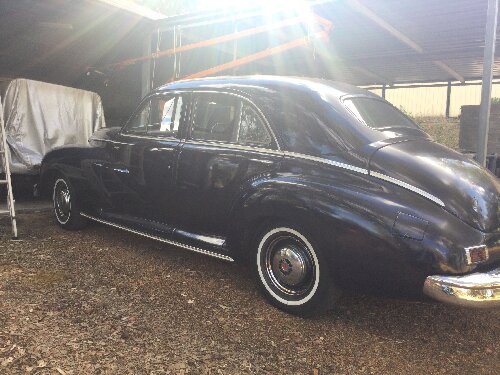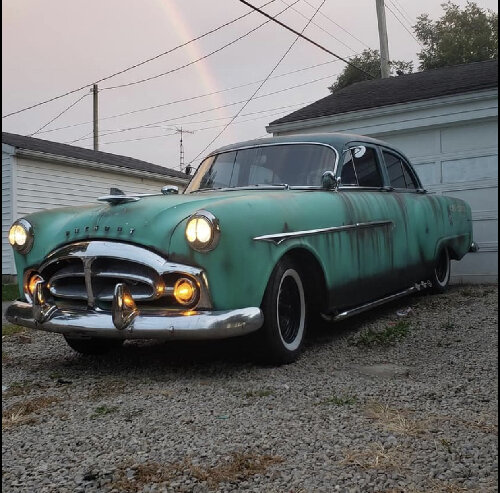|
Re: The Sudden End of the Detroit Packards
|
||||
|---|---|---|---|---|
|
Home away from home

|
Like the Chinese curse, Packard's last three Michigan years were "interesting." While I agree that no amount of speculating can un-do what seems like a shame, there must have been a lot of bad feelings going on among still-familiar names including Romney, Ford and McNamara that took its toll. George Romney, as President of the American Auto Manufacturer's Association was courted by Christopher and McCauley to be the new president of Packard in 1948. He turned them down and the "Hotpoint Hotshot", James Nance took the job in 1952. Romney, instead, went with George Mason's Nash-Kelvinator as it merged with Hudson. He scuttled Mason's merger plans with Nance's Studebaker-Packard, partly out of a dislike for Nance and his opportunism. Oh-well. We know how that ended. AMC would last another thirty years.
Looking at the final 1956 product in my garage, I am wondering who was deciding things at Packard when the final big cars were planned. Where were the engineering cost-cutters when the new trunk lids were fitted over the previous trunk's steel sub-structure? Did the 56's really need Autolite's pushbutton transmission to sell cars? Who said 12 volt negative ground had to happen? A whole new (but similar) front bumper and die-cast grille in an early (chrome) and later (gold anodized) grill? New rear axles and brake drums. And that 56 trunk latch is an engineering work of art! Richard Teague's head must have been swimming with all of these approved model changes as the circling of the drain was beginning. Not that I don't appreciate the changes, but the bean counters, today, would be having fits. Maybe that's the lesson that was learned. I'd say that the 56s went out with a very level and smooth Big Bang. Excellent to the end!
Posted on: 2014/1/25 14:10
|
|||
|
||||
|
Re: The Sudden End of the Detroit Packards
|
||||
|---|---|---|---|---|
|
Home away from home

|
It might have been more appropriate to compare the demise of the Detroit Packards with Plymouth, Pontiac, Saturn and Oldsmobile, rather than SAAB. But the same uncertainty that was going around with East Grand and Conner Packard employees was evident in the quiet factory in Trollhatten, waiting for a Chinese White Knight to come in and rescue a fine brand.
The rapidity of Packard's closing down their Detroit operations was shocking for me. Thousands of jobs suddenly gone, troves of parts and records destroyed and still 1,700 new cars (mine included) waiting to be shipped to dealers who dreaded what the next step might be. All while the other independents were desperately looking for sales just as GM and Ford were dealing with their own sales downturns by dumping their cars. Thank goodness for Ford taking in many loyal, quality workers from Packard. Those, like Bob Aller, who welcomed any port in a storm, looked forward to furthering their careers with the new Edsel brand, only to watch it crash while Henry II blamed James Nance for a second failure. The personalities of Nance, GM's Charlie Wilson, George Romney and Robert McNamara all played their parts, too. As far as business schools, I would hope that the lesson of checking the books of a potential purchase like Studebaker is stressed with the new MBAs. Without that millstone, we might have seen a few more years of big Packards coming out of Detroit.
Posted on: 2014/1/24 18:53
|
|||
|
||||
|
The Sudden End of the Detroit Packards
|
||||
|---|---|---|---|---|
|
Home away from home

|
I have just finished reading James Ward's 1995 text The Fall of the Packard Motor Car Company (Stanford University Press). I understand that several renowned business schools have used this as their adjunct text in their MBA programs of "what not to do" in running a business.
Prior to reading this, I was content to place most of the blame on James Nance. But after reading, I realize that he might have been more a central figure in a collision of events and trends that include the Korean War, the economic situation in the U.S., Fords and Chevys being dumped on the market, lack of accounting practices and a whole series of supplier problems that hampered smooth production of 55-56 models. What's a CEO to do when the new senior Packards cannot be finished because the manufacturer of the die-cast grilles is two weeks late in delivering? To make things worse, many of the dual-dealers didn't have a single car to display or demonstrate but did have a lot full of last year's 1955s. I suppose to capture a more recent feeling of those times is to ask if you'd still want to buy one of those left-over 2011 SAABs that might still be lurking at a former dealer? A good but different car, but are you willing to gamble? Shades of the summer of 1956 when tens of thousands of long-time Packard workers were shown the door in a down economy. My condolences.
Posted on: 2014/1/23 20:15
|
|||
|
||||
|
Re: Owner Registry - Time to get on board!
|
||||
|---|---|---|---|---|
|
Home away from home

|
I have seen your message but haven't seen any PM yet. Look forward to hearing from you. I took some extra Esquire photos this afternoon , just for your restoration benefit.
The fellow I bought mine from has told me several dozen Esquire stories, some best not mentioned here. The whole Harry Du Bois saga is an interesting one, but you may already know that. Luckily, that fellow, a son and grandson of Packard dealer mechanics in VA and DC, is also alive and well in north Georgia. He's known of several Esquires, including a Patrician that was regularly serviced by his father at a DC area dealership.
Posted on: 2014/1/17 16:55
|
|||
|
||||
|
Re: How Packard Builds a Body c1930
|
||||
|---|---|---|---|---|
|
Home away from home

|
The silent Packard film, Part 3, really drives home the complexity in making a fine car with a wood-framed body. Even with the metal jigs to keep bodies somewhat consistent, I'm sure a slap with a mallet or trim with a wood file is inherent in the history of these cars. As for the behavior in a collision, you need look no further that that interesting drive down (Wilsher?) the 1935 Los Angeles street in another film that was shared on PI earlier this week. For a few seconds you see a tow truck hauling a virtually collapsed wreck of a sedan. The next likely fate for that car might be a bonfire and I wonder how well the occupants fared?
My grandmother's household once had an early 1920's Nash touring car that was hit from the side. Since it was then a relatively new car, no authorized repairs could apparently be made in St. Louis and the car was shipped off to Kenosha for rebuilding. It was gone three months and was apparently still unsatisfactory when it was returned. That began a steady series of Packard purchases by the family until they switched to Buicks after WW II. Luckily, none of those Packards got hit or the brand switching might have affected them, too. In St. Louis, when 1954 Corvette production shifted from Flint, operations were set up in the circa-1919 "Mill Building" (plant 19). That building had been largely under-utilized after Chevrolets moved to "all steel Turret Top" construction in 1933-34. Perhaps some might think that making cars out of fiberglass instead of wood was a natural progression. With many additions and modifications, that Mill Building cranked out Corvettes until 1981.
Posted on: 2014/1/11 13:48
|
|||
|
||||
|
Re: dome light repairs
|
||||
|---|---|---|---|---|
|
Home away from home

|
Thanks for your advice. I hadn't thought of checking the rear ashtray lighters or any of the other lighters since we're a family of non-smokers. Better yet, I will review the headlight switch instructions contained in (the PI version) of the on-line owner's manual for 1956, to see if I'm doing things right.
But all of this will have to wait for the Arctic Vortex to go away. Last night Atlanta had its lowest temperatures in almost a century and two degrees short of an all time low. In a cold garage, it may be best to leave sleeping Packards to their sleep. By the weekend we may be back with weather approaching the seventies (F) and then being upside down, under the dash, will be more tolerable for an old guy. You've given me some helpful advice and at least two places to start. Seeing the pictures of others re-crafting their own wiring harnesses is a source of amazement and admiration. Thank you. Dave
Posted on: 2014/1/7 13:47
|
|||
|
||||
|
Re: dome light repairs
|
||||
|---|---|---|---|---|
|
Home away from home

|
This topic has proved interesting and motivating for me to seek some reason in the behaviors of my own 1956 Four Hundred (Esquire) hardtop.
When I got the car, the rear two dome lights did not have bulbs in either socket and I soon found out why. First, if I were to disconnect the car battery, I could put good bulbs into the sockets, and if the car doors stayed closed, once the battery was re-connected, both dome lights would come on, the under-dash courtesy light (above the radio) would stay off, as would the side marker lights, right and left. But when I would try to open a door, the courtesy dash light and the side marker lamps would come on (as expected), but the dome lights would flutter and then the fuse block fuse would blow. Without any bulbs in the dome light sockets, there is no fuse blowing and the other lights work as expected. If it matters, I also have no operating trunk light, either. My study of the wiring diagram seems to show that there is no slide on/off switch for the hardtops, unlike the sedans. Baring the bare wire theory, I am reluctant to start pulling things apart unless there's a good plan for where to start. I can live with the prospect of a dark back seat for a very long time. But if I'm overlooking something more obvious, I am willing to try for a solution. Any ideas?
Posted on: 2014/1/7 12:21
|
|||
|
||||
|
Re: How to Identify a 1956 >>374 block?
|
||||
|---|---|---|---|---|
|
Home away from home

|
A couple of points, once I say that the pictures of the car really make look sharp and attractive. It will be interesting to see which neighborhood the ending bids are in.
Now for the nit-picks....Somewhere the casting numbers discussed by others will reveal the true displacement of the engine. But it the last four match the body number (1034) then it's more likely that it came with the car. That's a very early production number for a Caribbean making it one of the first three dozen. But the lack of a pushbutton gear selector in favor of the lever makes me wonder....I thought that PB was standard only on the Caribbeans (although dealers could try and specify almost anything if Packard made it) If it was somehow original to this car, that might make it unique. Secondly, the single four barrel Rochester might also make it unique among the Caribbeans. I was told by the son of an old Packard mechanic that the dual four barrel cars were among the first to suffer crankshaft failures and replacements because of carbs leaking raw gas down the cylinder walls, diluting oil, etc. Sometimes, in order to keep an expensive Caribbean owner happy, a dealer might replace the failed engine or revert to a single 4 barrel. I wonder if that might explain some of the engine/ carb strrangeness? Still, the lack of PB transmission controls is a puzzle in need of a solution. And finally, engine stamped numbers can be faked, but that's not too likely unless someone is really trying to be fraudulent.
Posted on: 2013/12/30 21:23
|
|||
|
||||
|
Re: What is the most unusual bit of Packardiana in your collection?
|
||||
|---|---|---|---|---|
|
Home away from home

|
My 56 hardtop came to me with a device, located under the dash, just to the right of the TL switch, that used vacuum to draw up either engine oil or transmission fluid into a split sight glass. It has two pushbuttons labeled T and C and has a single light bulb to illuminate the fluids from behind. It is now disconnected, but the previous owner said it was in lieu of both underhood dipsticks. If you pushed the button and no oil appeared in the sight glass, you knew that you were low and should add some. I'm supposing that the vacuum would have nothing to draw up but air if the levels were below a certain point. Wisely, the car now has real dipsticks for both functions, but it leaves me to wonder if anyone knows the name or brand of the device, or how it worked in real life. The color matches the rest of the dash paint, so I am wondering if this might have been sourced by the dealer and probably not from a J.C. Whitney catalog?
No vacuum-powered ashtrays, but there's also a nicely done pull lever that retards the distributor timing for easier warm weather starting. It is still connected but the car seems to start nicely, warm weather or cold, without using it.
Posted on: 2013/12/22 12:40
|
|||
|
||||








